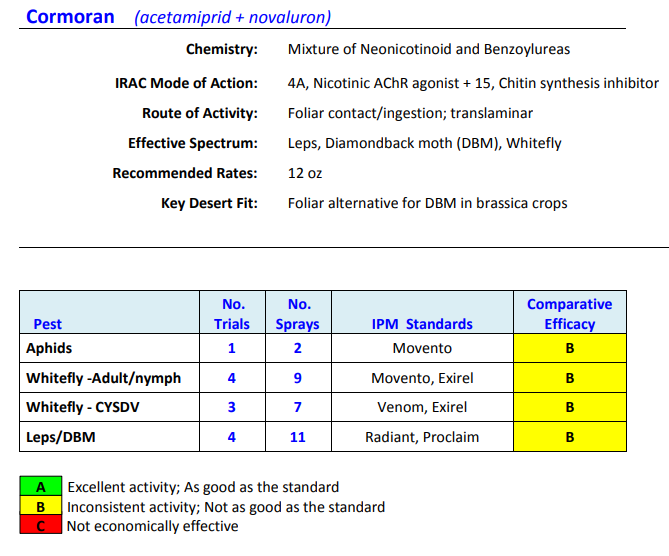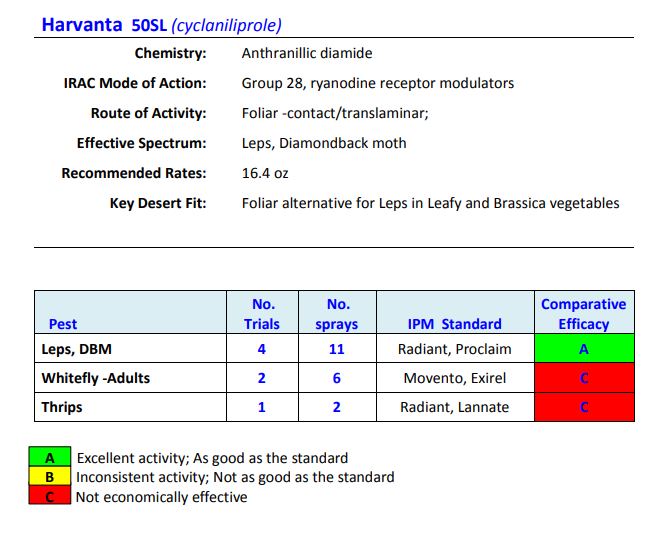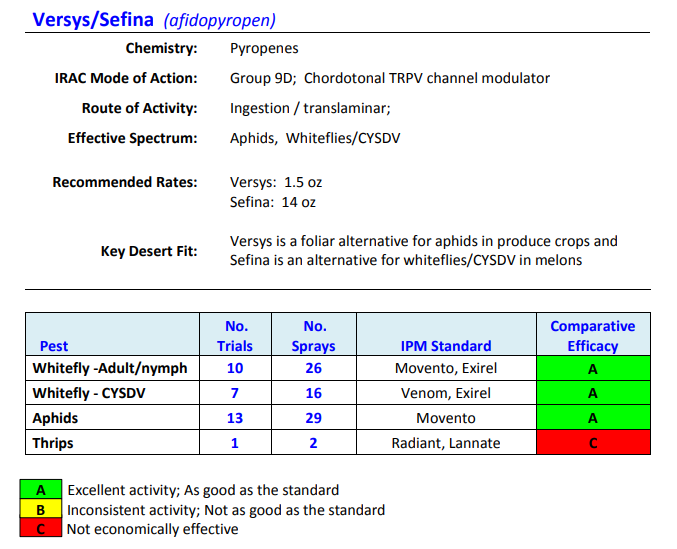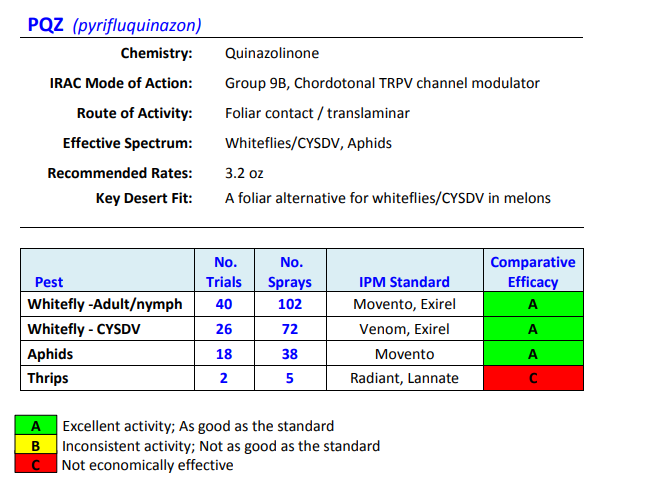In the past 25 years, there has been an unprecedented development of insecticide chemistry that has resulted in the registration of a number of key products in desert crops. Among these were several breakthrough chemistries that have had a major impact on how PCAs manage insects on leafy vegetables and melons. The first important chemical class developed were the neonicotinoids with the registration of imidacloprid (Admire 2F) in 1993. It was the first selective, systemic insecticide developed for whiteflies and aphids. Since then a number of other neociotinoid compounds have been registered (acetamiprid, thiamethoxam, acetamiprid, clothianidin, dinotefuran). The second major breakthrough chemistry to be developed for desert crops were the spinosyns lead by the registration of Success/Entrust in 1997 and followed most recently with Radiant in 2008. The spinosyns were one of the first Reduced-risk chemistries developed, and have excellent activity against both Lep larvae and thrips. This was followed by the Ketoenols (Tetramic acid derivatives) with the registration of Oberon in 2003 and later Movento in 2008. Movento was the first fully systemic insecticide to adequately control whiteflies and aphids via foliar application. Finally, the anthranilic diamide chemistry was developed most recently and included two active ingredients, chlorantraniliprole (Coragen, Besiege) and cyantraniliprole (Exirel, Verimark, Minecto Pro) that provide activity against chewing and sucking insects via foliar sprays, and for the first time, activity through soil, systemic activity. There have also been a number of other key chemistries that play a key role in desert IPM programs with products such as Courier, Knack, Beleaf, Intrepid, Proclaim, Sivanto, Sequoia and others. Without question though, the products now available for use in desert vegetable crops are more effective and safer to use than compounds used prior to 1993.
In 2019, several new insecticide products have recently been registered for management of key insect pests found on desert produce crops. PQZ (pyrifluquinazon) just recently received its Arizona label and is currently registered for use against sucking pests in leafy vegetables and melons. Similarly, Sefina and Versys (afidopyropen) are registered for sucking insects in in leafy vegetables and melons. Two other compounds, Cormoran (an in-can mixture of novaluron and acetamiprid) and Harvanta (cyclaniliprole) have been available for a year or so, and are active against Leps. At the Yuma Agricultural Center (YAC) we have been working with these compounds to better understand their insecticidal activity and fit in local IPM programs. Below, information is provided on each of these compounds with a description of their route of activity, MOA, effective spectrum and rates and Key Desert Fit. Furthermore, we provide a product summary and an Index of Efficacy for each compound that ranks their comparative efficacy against the local standards. These ranking were derived from evaluations in multiple field trials and applications conducted at YAC. The product was given an A if it showed consistently good control comparable to the industry standard; a B when inconsistent control was measured relative to the local standard, and a C when its activity was not economically effective (consistently poor control relative to the standard and untreated check). Finally a summary of the label attributes for each compound is provided.

Cormoran (acetamiprid + novaluron) is formulated as a dispersible concentrate insecticide, and is currently registered for use on Brassica vegetables and melons in Arizona. It is an in-can mixture of the neonicotinoid acetamiprid with novaluron, an insect growth regulator. Because it has IGR activity, it can be very slow acting, particularly against Leps. In limited trials conducted at YAC, it has shown activity against whitefly adults and immatures, but has been inconsistent in suppressing CYSDV in cantaloupes. Most of the adult whitefly activity appears to be due to the acetamiprid component, albeit at a reduced rate (3.3 oz) from top of the label Assail. It has significant activity against diamondback moth larvae and provides an alternative mode of action for use in DBM resistance management programs. However, Cormoran has not been shown to be as effective against beet armyworm and cabbage looper as standard products. According to the label, Cormoran is toxic to bees exposed to direct treatment.



